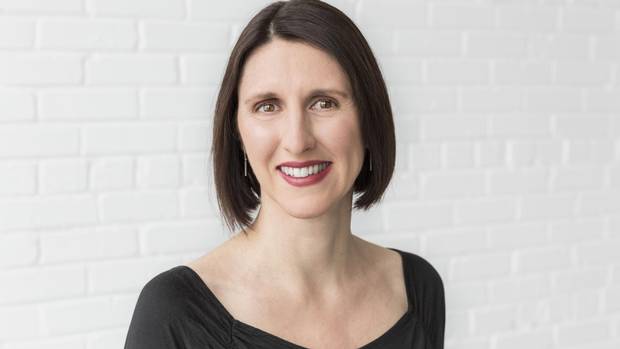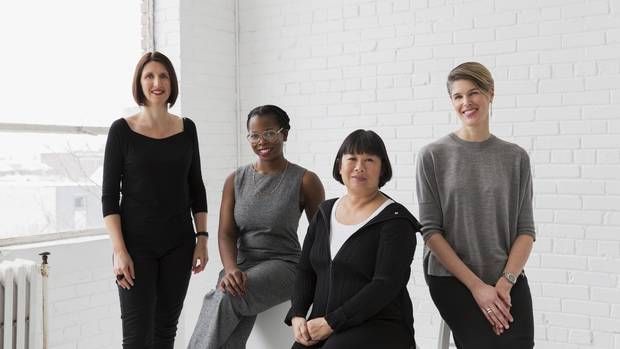The site supervisor wasn't sure if he should invite the lady to the Christmas party. This was the late 1970s, during the construction of a federal building outside Edmonton. The lady was Vivian Manasc, then a twentysomething architect and often the only woman working on the project.
The party had "girls serving drinks who were not heavily dressed," Manasc says. "There was definitely a Playboy feel to it." In the end, the builders threw a second party, "to which wives and daughters and ladies were invited," Manasc, now a principal at her own firm, Manasc Isaac, says. But the bunnies kept hopping.
That was nearly 40 years ago; such institutional sexism wouldn't be tolerated on a building site today. Yet other things haven't changed much in that time. While Canadian architecture has some women among its leading lights, including Patricia Patkau of Patkau Architects and Brigitte Shim of Shim-Sutcliffe, the profession remains overwhelmingly male.
According to Annmarie Adams, a McGill professor and co-author of the study Designing Women: Gender and the Architectural Profession, approximately 20 per cent of Canada's registered architects are women. At the Royal Architectural Institute of Canada, a national organization, just 1,138 of its 4,860 members, about 23 per cent, are women.
Heather Dubbeldam
"Historically, creativity hasn't been gender specific. In every creative discipline women have played a role. And in architecture, I haven't noticed something that's been holding me back. You need all sorts of people around the table; in order to really make good work, you need all sorts of perspectives."

RAINA+WILSON
And that's a challenge, not just for the design profession but for the rest of society. Is it possible to shape buildings and cities that will work for everyone if women's voices are so rarely leading the design process?
Toronto-based architect Heather Dubbeldam will be speaking, along with fellow architect Megan Torza, at Globe Style Saturday at the Interior Design Show, Jan. 21, on just that subject. Dubbeldam, who is the principal of Dubbeldam Architecture + Design, and Torza, who is a partner at the firm DTAH, have distinguished themselves as designers, rising quickly in a profession that favours men.
Dubbeldam's office has thus far largely designed private houses, winning a slew of national and international awards for its design quality. Now, the firm is shifting toward commercial and residential projects, including an interior for the tech firm Slack and a new building for the Canadian Centre for Rural Creativity.

Heather Dubbeldam’s Through House reimagined a 127-year-old structure as a light-filled space.
Dubbeldam Architecture + Design
And at her established Toronto firm, which joins architecture, landscape architecture and urban design,
Torza is currently partner-in-charge of the Tommy Thompson Park Entrance Pavilion project and the master plan for the adaptive reuse of the Jury Lands in Bowmanville, Ont. She also worked on the design of Toronto's Evergreen Brick Works and Wychwood Barns. "My work has had two threads: community and sustainability," she says.
When we sat down recently for a conversation about their careers and the state of their profession, neither seemed eager to focus on their status as women in architecture. "I don't like to think of myself as a female architect," Dubbeldam says. "I think of myself as an architect, period." And yet both, having achieved success in the profession, are aware of particular barriers to women within architecture.
Megan Torza
"Women need to be really explicit about their role. They need to make clear just how they contribute to a team, which is a strength. A lot of the best architecture is, in some way, egoless: Great architecture comes sometimes from the architect taking a very light touch and letting themselves be guided by the clients. At the same time, the creative process is very personal, so how we balance that – and how you share your work and articulate your role – is really important."

RAINA+WILSON
Some challenges are similar to those found in other white-collar jobs: heavy educational requirements and long work hours, especially during the first act of one's career. "A lot happens in the years between 28 and 40," Torza says, "which are eventful years in a woman's life." In her own case, she says, she kept her focus on the office with the encouragement of her partner. "I had an opportunity in those years to put my head down and work, which – along with mentorship – is how I managed to make partner."
But architecture is also a profession that demands design skill, the ability to manage complex projects, all sorts of technical and business expertise and a large dose of people skills. Architects negotiate between the needs and desires of their clients – people with money and power – and work to realize their vision in the world of construction. "We're only one small piece of the industry," Dubbeldam says. "Construction and developers and engineers all tend to be male."

As part of the team that reimagined Toronto’s Evergreen Brick Works, Megan Torza contributed to the reinvention of the site as an eco-friendly hub for community, arts and social initiatives.
Tom Arban
Communication – stereotypically something that women excel at – is critically important; Dubbeldam has turned this to her advantage. "On [construction] sites, I've found that being a woman in that role was an asset," she says. "It's a very confrontational, difficult, stressful industry, and being able to handle situations delicately is a real asset."
Though they prefer not to dwell on it, both women have experienced sexism in their professional lives. Dubbeldam says that her peers treat her "with absolute respect," and yet she remembers, as a young architect, hearing condescending remarks: "'A woman on site! That's so cute,'" she recalls. "But after you've had your first conversation about the work at hand, about the technical challenge you're facing, the people around you start taking you seriously." Torza adds: "You have to have a thick skin."
This sort of battle for respect – the challenge to do what men do, but better – also applies to architecture's intellectual leaders. The sudden death in 2016 of Zaha Hadid, easily the most prominent female architect, brought this into focus: Where were her heirs? Why have so few women ascended to the intellectual heights of the profession?
Camille Mitchell
"'People wouldn't imagine minorities as architects. Black women are very rare in architecture, and I think it's exposure to the profession that is missing. My father was a draftsman, and that helped me find my way but if he wasn't there, I wouldn't be doing what I do, which is very satisfying for me. We need to reach out to minorities, even before architecture school, so they can find their way in."

RAINA+WILSON
To be sure, there are some trailblazers; the most prominent woman in the business today is Chicago-based Jeanne Gang, whose firm Studio Gang is an industry leader. And yet only two women (
Hadid and Kazuyo Sejima) have won the Pritzker Prize, architecture's most prestigious award, since its beginnings in 1979.
This near-omission of women architects has been insidious. In 1991, the Pritzker went to Robert Venturi, the American architect and theorist – but not to his wife and professional partner Denise Scott-Brown, who has been his lifelong collaborator in the office Venturi Scott-Brown Associates. In 2013, a group of students at Harvard University organized a petition; they proposed that Venturi's Pritzker should retroactively be shared with Scott-Brown. The prize's organizers shot the idea down.

At KPMB, Camille Mitchell is working on a lofty, collaborative space for the Kellogg School of Management at Northwestern University in Evanston, Ill.
KPMB Architects
The petitioners were drawing attention to a theme at the heart of architecture: Many of the most successful women in the field practice together with their husbands. In Canada, Brigitte Shim and Patricia
Patkau both fit that mould – and their offices are among the most decorated design firms in Canadian history.
Torza says this sort of small business-slash-marriage provides "the ability to design your own life," and thus to manage the challenge of work-life balance in a novel way. New Brunswick's ambitious Acre Architects have done just that: The husband-and-wife couple of Monica Adair and Stephen Kopp brought their two kids into the office for more than a year each, sharing childcare between them and their staff. They built a playhouse in their studio, nicknamed HugoBureau, for their older son. "Because I don't care about the rules very much, I was able to do it," Adair says.
On the other hand, Adair says, work-life balance isn't much of an issue when you are consumed by what you do. "Stephen and I are people who love to work, and there is no boundary," she says. "I'll wake him up at 2 a.m. when I have an idea, and vice versa."
Brigitte Shim
"As our cities become denser, we need to ensure they also are more humane. We all need to continue to create places for gathering that reflects our evolving definition of community. Women have a critical role to play in ensuring that this reshaping of our urban landscape reflects who we are and what we believe in."

RAINA+WILSON
Many architects do marry each other – architecture school is an intense experience that bonds peers – but that model won't work for everyone, because the profession's work culture, which includes long hours and intense teamwork to attack a problem, makes it hard to step back.
And then, on top of designing, many architects are small business owners, and running a business and finding clients are even more difficult if you lack a network of people who might commission a project. Camille Mitchell, an architect at the Toronto firm KPMB, sees this as a problem for women, as well as people of colour and members of historically disadvantaged groups.
"You need clients. So yes, I'm an architect, but who am I working for?" Mitchell says. "It helps to have connections to established wealth. I had [friends] who left architecture school and were designing cottages for their relatives right away."
One of the most photographed homes in Canada, Shim-Sutcliffe’s Integral House features a concert hall that overlooks Toronto’s Don Valley.
Shim-Sutcliffe Architects
Mitchell is enthusiastic about her workplace – two of
KPMB's three principals, Shirley Blumberg and Marianne McKenna, are women – and she is involved, along with Blumberg and several colleagues, in the advocacy group Building Equality in Architecture Toronto. She hopes, through outreach, to draw more women into the profession – and keep them there. Though women already outnumber men in many architecture schools, they are much more likely to drop out of the profession, because of, among other things, the profession's workaholic culture, the macho attitudes that survive within the building industry and the business world.
If the buildings and cities we live in are predominantly designed by men, they can't serve everyone's needs. And if this cycle continues, something of architecture's magic will be missing. "Architecture is about dialogue," says Manasc. "The work gains from this magical synthesis from the multiplicity of perspectives we bring to the table."
Heather Dubbeldam and Megan Torza will speak with Alex Bozikovic during the Interior Design Show's Globe Style Saturday on Jan. 21 at 11 a.m. For more information, visit www.interiordesignshow.com.
PHOTO SHOOT CREDITS Makeup and hair by Wendy Rorong for M.A.C Cosmetics/FHI Heat Tools/Plutino Group and Claudine Baltazar for Dior/Davines/Plutino Group.
